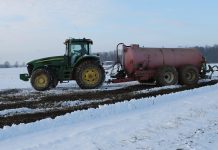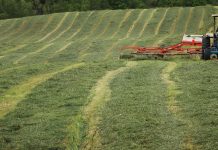Low milk prices are having a real impact on dairy farmers and most are looking for ways to reduce expenses, while maintaining milk production.
Jim Paulson, University of Minnesota Extension, published an article on this topic. Below is a summary of the article.
What is better for your dairy? Trying to cut expenses by a dollar per cow per year or a nickel per cow per day or a penny per hundredweight?
Where can I cut costs?
For every hundred cows you milk, you will save $100 for every dollar you cut in production costs per cow.
If each of those cows is putting 24,000 pounds of milk in the tank each year, finding $0.01 per hundredweight in savings will save $240 per 100 cows per year.
If you can save $0.05 per cow per day in feed costs or other costs, that will add up to $1,245 per 100 cows per year.
It does little good, in the face of a cash flow shortfall, to say that you need to be a better manager or become more efficient. You probably are the same manager now as when the milk price was $25.
Most good dairy producers strive to do the best they can every year. What we need is careful examination of the situation we have to make some decisions.
When cash is short, we might have to make some tough decisions. Typically, the biggest expense categories for the dairy enterprise are feed — both purchased and farm produced — and labor.
Next will usually be depreciation and supplies — these are generally substantially less — followed by veterinary, drugs, and repairs.
Other categories make up the balance and may vary slightly from farm to farm. While we call these variable expenses, for the dairy enterprise alone that is holding its size steady, they may be fairly constant with not a lot of room to cut.
In times of tight cash, purchased feed and veterinary expenses get cut because they can.
Five rules to remember
Rule No. 1: “Do not cut anything that cuts milk production.”
That is usually bad economics. Your focus should be on income over feed costs. That is your margin to pay the other bills. Does it line up with your margin protection plan?
– – –
Rule No. 2: “Don’t do anything that will hurt pregnancy rate.”
Next to feeding and milking, getting cows pregnant is the most important thing you need to do for your dairy to remain profitable.
Remember, your goal is 150 days in milk. Lower days in milk usually mean higher milk production and lower feed costs per cwt of milk.
Since feed does represent your largest expense category by far, spend time closely examining how you can lower your feed cost per cwt of milk.
The first question is, “Do you know what your feed cost is?” Work with your nutritionist or other consultants to determine your feed cost.
– – –
Rule No. 3: “Calculate your feed cost per cwt of milk every month.”
Break that out for the milking cows and then add all animals on the farm. Calculate daily feed cost per head for each group of animals.
Then, considering your production and milk price, ask yourself how many dollars of milk per cow per day are going out the door each day?
How much is that right now? Is it $12, $13, $14, or more? The next part of the equation is “Is my feed cost per cow per day about half of the value of the milk going out the door per cow each day?”
– – –
Rule No. 4: “The best way to lower feed cost per cwt is to have higher milk production to spread the cost over.”
(See rule No. 2) Think about it this way: Have half of your cows at less than 150 days in milk and no cows over 365 days in milk.
You are more likely to have higher and more efficient milk production early in lactation.
– – –
Rule No. 5: “The best way to lower purchased feed cost is to have higher quality forage.”
Remember, your nutritionist is only as good as the forage you give him or her to work with. High quality forage lowers purchased feeds needed and total feed cost, and increases dry matter intake and production.
This may also affect your forage mix that you feed your lactating cows.
Alfalfa to corn silage ratios influence purchased protein supplement amounts; but digestibility of the forage, whole farm yields and cow preference all need to be taken into consideration.
Be careful what you cut
But the question does come up, “Is there anything I can cut out?” It is always valuable to look over all the ingredients and their costs.
But first think about the fact that if it made sense at $25 milk, it most likely still does at $14 milk as well.
Profitable milk production begins with healthy diets, balanced for the level of milk production you want, using your feeds and adding what you need.













